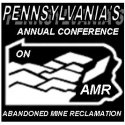Reclaimed Abandoned Mine Land Inventory System (RAMLIS) GIS Tool: A new weapon to wage war on the leftovers of mining!

Now in Version 21 and Interactive Web Map Beta
Use the map below, order the more robust Data CD for $15 or Digital Download for $10 from the EPCAMR Store or download the older  KML file (for Google Earth)
KML file (for Google Earth)
View the web map at epcamr.maps.arcgis.com
There are limitations to what can be displayed and searched on an interactive web map. If you want the full functionality of RAMLIS, you will want to order a CD or digital download from the EPCAMR Online Store.
The following is a write-up on the RAMLIS GIS tool:
A regional abandoned mine reclamation group has created a powerful new tool for mapping mine-scarred lands in affected municipalities.
The Reclaimed Abandoned Mine Land Inventory System (RAMLIS) can pinpoint waterways plagued by Abandoned Mine Drainage (AMD) and areas — down to the street and house level — potentially prone to mine subsidence. Its creators believe the information can aid elected officials and conservation groups in targeting cleanup projects and funding. The expansive program may also help keep mine reclamation moving all together. The federal fund that doles out money for mine reclamation projects is in jeopardy. Stakeholders say this highly detailed system can help illustrate just how much cleanup work is left to do.
“If we can convince these folks that are in charge of making things happen … it might put the light bulb on for them,” said Robert Hughes, Executive Director of the Eastern Pennsylvania Coalition for Abandoned Mine Reclamation (EPCAMR). “We’re trying to say, ‘Here, we’ll show you how to allocate that funding over time.'”
A data treasure trove
The Geographic Information System (GIS) modeling program uses state and federal data to create interactive maps, which can show a host of features, including mine discharge points, back-filled stripping pits, and reclaimed mine shafts. Representatives from the nonprofit coalition are taking the technology on the road to municipal officials throughout Northeastern Pennsylvania, giving many a new perspective on what’s within — and often below — their boundaries.
More than mine land. Don’t let the name fool you.
RAMLIS gives detailed, interactive images of a community’s mine-scarred lands. But, its layers of data hold much more information and potential, according to its creators at EPCAMR.
The GIS modeling program can produce high-tech maps for dozens of municipal needs. It simply depends on what you input.
The system can document sewer systems and combined sewer overflow points for an entire watershed. Elected officials can input tax and income figures to examine their base. Planning commissions can use the maps as a tool for land-use planning, stormwater and floodplain management, and a host of other development-related issues.
“We have so much information, you have to pick and choose,” said Mr. Hughes.
Old Forge Borough played host to the program’s first display in Lackawanna County. Council President, Tony Pero, one of the few regional officials who popped in for the two-hour session, got a detailed look at mine shafts, impaired creeks, and culm piles throughout the borough.
“We don’t have anything that looks like this. I’m pretty impressed,” said Mr. Pero. “Looking at the big picture, I think it helps a lot.”
Mr. Hughes said the information can help municipalities prioritize their cleanup needs, as well as give state and federal officials concrete evidence of possible health and safety hazards. “That’s a priority for these communities,” said Mr. Hughes.
Funding is a key
The federal Abandoned Mine Land Reclamation Fund is maintained by the Office of Surface Mining (OSM). Today’s coal mine operators feed money into the interest-accruing account through a per-ton fee. Legislation governing the fund expired several years ago, but has been extended year to year.
Environmental groups are pushing for a full re-authorization of the law, which would guarantee the flow of funds in and out of the federal pot. “About 1.4 million Pennsylvanians live within two miles of abandoned mine sites,” said Brian Hill, chief executive officer for the Pennsylvania Environmental Council (PEC).












You must be logged in to post a comment.